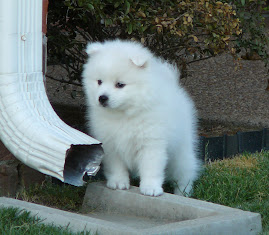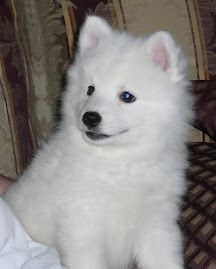We really spoiled our little Geisha (our very first JS) when we got her. For the first year of her life, she got everything she wanted - Every kind of pampering imaginable, every type of tasty food/treat available. When she wanted something, the word "No" was rarely used. We had no idea how easily this breed takes to spoiling, and we unintentionally created quite the diva.
It was after she turned a year old that she exhibited the first signs of food aggression. One day after a shopping trip, I brought home a few very special bones for the dogs. BlackJacks finished his immediately. Sami was just a puppy & his little puppy jaws had gotten tired, so he gave up & went to play with his stuffed bear. After about 20 minutes, Geisha was still working away on hers, and since it was about to get dark outside, I really needed her quit focusing on the bone and come inside. The problem was, all she wanted to do was chew on her tasty new bone. Frustrated that she was ignoring me (something that was normally unlike her), I walked up to her & took the bone away. She got mad then growled and snapped at me. I was stunned! I couldn't believe it. My precious little angel was not acting very angel-like. So, after smacking her little bottom & bringing her inside, I did the only thing I knew to do - I studied up on the best way to nip the problem in the bud.
Guarding food in any form (whether by biting, growling, a confrontational stance, etc.) is always a big No-No and should never be tolerated. This is one thing that all shelters test a dog on beforing OK'ing it for adoption. It is very sad (and I completely disagree with this practice), but if a dog shows food aggression in a shelter, it is often euthanized. This is unfortunate, because it is very possible to train food aggression out of a dog, if the dog is lucky enough to have someone willing to take the time to do so.
In order to correct this bad behavior, you have to understand why your dog feels the necessity to exhibit the behavior in the first place. Food aggression typically occurs when your dog feels that the food in her bowl (or the bone she is chewing on) actually belongs to her. In the wild wolf packs, the alpha males/females eat first. Then, they may allow lower dogs in the pack to eat some of the meal. The lower dogs in the pack understand that the food actually belongs to the alpha(s), and that they are only able to eat because the alpha(s) allow it. So, the solution here is obvious. You need to make your dog realize that all the food/bones/toys in the house actually belong to you. You are just allowing her to eat it/play with it.
To do this, you'll need to begin by changing the way you feed your dog. Initially, don't give her whole bowls of kibble at a time. Put dog food in her bowl and hold it your hand. Now, with your other hand, let her see you pick up some kibble & put it to your mouth. Act like you're eating it & let your dog think you are eating it. She may be shocked at first and wonder why in the world you are eating her food. Now, pick up some more kibble and give it to your dog. Let her eat it from your hand. Repeat the process until the food is gone & do this for a day or two. If your dog eats wet food, then just use a spoon instead of your fingers. Now, if you feel like your dog has made progress and no longer exhibits a "sense of entitlement", you can move on to the next step.
Put the bowl down for your dog to eat out of. Then, while she is eating out of the bowl, every-now-and-then use a spoon to stir the food/kibble inside (use a long-handled spoon if you're still a little worried about biting). If your dog growls, snaps, etc., pick up the bowl of food and take it away. Hold the bowl of food in your hands (out of the dog's reach) until she calms down or sits politely. Then you can put the bowl back down & let her eat out of it again. Repeat this process a couple of times during each meal until your dog learns that her possessive attitude toward the food is unacceptable.
If you have taught your dog how to sit/stay. Put her in that position before putting he
 r food bowl down for her to eat out of. Don't allow her walk over to the bowl until you give her the release word & tell her it's now OK for her to eat. This again reinforces to her that the food belongs to you. I recommend doing this every meal throughout your dog's life. We do this with all three of our JS, even though the other two never showed any signs of becoming food-aggressive. It is simply an easy way to continually re-affirm our positions as the pack alphas.
r food bowl down for her to eat out of. Don't allow her walk over to the bowl until you give her the release word & tell her it's now OK for her to eat. This again reinforces to her that the food belongs to you. I recommend doing this every meal throughout your dog's life. We do this with all three of our JS, even though the other two never showed any signs of becoming food-aggressive. It is simply an easy way to continually re-affirm our positions as the pack alphas.I'm glad to say that it only took one or two feeding sessions for Geisha to realize the "pecking order" had changed. It only took about a week or so before all food aggression was completely gone. We can now stick our fingers in her bowl and play with her food while she is eating, and it doesn't effect her attitude or demeanor in the slightest. Sure, she's still a little diva, but a sweet diva we can deal with. :)

 Pia Silvani, certified dog trainer and animal behavior consultant, suggests dual toy storage: Allow only chew toys in the house. Keep raucous-time fetch toys outdoors, perhaps in a bin on the back porch. Not only is this orderly, but this way the dogs learn that when it's time for [rambunctious] play, we go outside.
Pia Silvani, certified dog trainer and animal behavior consultant, suggests dual toy storage: Allow only chew toys in the house. Keep raucous-time fetch toys outdoors, perhaps in a bin on the back porch. Not only is this orderly, but this way the dogs learn that when it's time for [rambunctious] play, we go outside.











